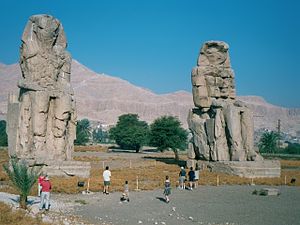This was actually surpassed in the late 18th century. The "Thunder Stone" (the base of the Bronze Horseman statue in St. Petersburg) was even larger (1500 tons) and was successfully moved over both land and water. Pain in the butt? You bet. But the journey was accomplished with nothing but human labor.Gumby wrote: It would have weighed nearly 1,200 tons upon completion and would have been transported hundreds of miles from that quarry. Archaeologists suggest that laborers would have used ropes to pull it onto a barge, transport it hundreds of miles, and then raise it in its desired location. But archaeologists haven't been able to successfully move or raise something even close to that scale before with the system they've imagined.
And the Egyptians never even tried to moved their obelisk out of its quarry.
Not lost -- there are plenty of diagrams that show how it was done. For example:Gumby wrote:All this supposed "rope-pulling" technology and laser-precision stone cutting lost somehow.
http://www.sciencedaily.com/releases/20 ... 104302.htmTeams of oxen or manpower were used to drag the stones on a prepared slipway that was lubricated with oil. Said Redford, a scene from a 19th century B.C. tomb in Middle Egypt depicts "an alabaster statue 20 feet high pulled by 173 men on four ropes with a man lubricating the slipway as the pulling went on."
The great insight of the Egyptians was how to eliminate enough friction to get these big stones moving. As for the precision, I'll grant you that it's extremely impressive. But "space-age" is a bit of a stretch.
A great link with good material on how this was likely done. It has some very nice Egyptian diagrams that show with great details how these big stones were moved. http://www.ancient-wisdom.co.uk/extremasonry.htmIt has been estimated that a ratio of two men per ton would be required for moving loads over flat surfaces; nine men per ton would be required for moving loads up a 9° slope. Practical experiments moving loads on a sledge over a lubricated track have shown that one man could pull one ton (or an oxen, five tons).
Magnetic North shifts by something like 25 miles per year and has shifted nearly 700 miles in the last 150 years alone. Considering that these sites are all from different time periods, you can't talk about pointing to "Magnetic North" unless you specify Magnetic North when. (Unless you are talking about a very low degree of precision, in which case MT's climate hypothesis makes the most sense.)Gumby wrote:All while the Egyptians had no clue or reference to the fact that they had built their largest pyramid perfectly along a precise global circumference — that sits at exactly 30º to the equator — with the other sacred monolithic sites around the world: Easter Island, Nazca, Machu Picchu, Petra, Siwa, Tassili n'Ajjer, the Pyramids of Paratoari, Ollantaytambo, Aneityum Island, Preah Vihear, Sukhothai, Pyay, Khajuraho, Mohenjo Daro, Persepolis and Ur... all sharing Magnetic North as their geographic pole.



 [/align]
[/align] [/align]
[/align] [/align]
[/align] [/align]
[/align] [/align]
[/align] [/align]
[/align]
 [/align]
[/align] [/align]
[/align]
 [/align]
[/align] [/align]
[/align]
 [/align]
[/align] [/align]
[/align]




 [/align]
[/align]
 [/align]
[/align] [/align]
[/align]